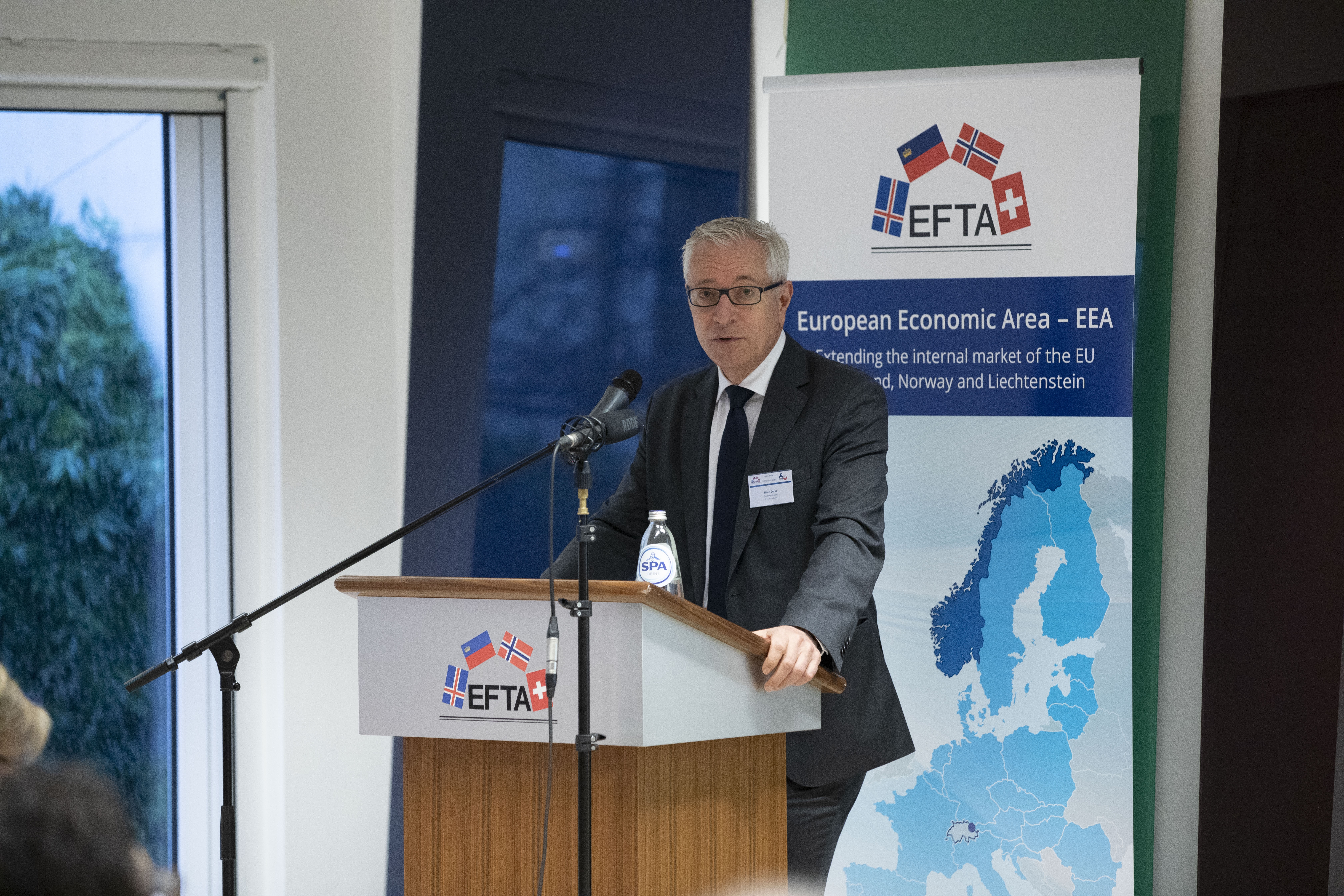
EFTA holds successful and increasingly popular seminar on the European Economic Area

On 13 February, around 150 participants from both the public and private sector gathered at the EFTA Secretariat in Brussels for the biannual seminar on the European Economic Area (EEA).
The seminar provided professionals with a thorough understanding of the EEA Agreement and made clear how it integrates Iceland, Liechtenstein and Norway into the EU’s Internal Market.
Secretary-General Henri Gétaz welcomed the participants. In his speech, he highlighted the uniqueness of the EEA Agreement and the special relationship between the EEA EFTA States and the EU.
“For Iceland, Liechtenstein and Norway it is of great importance that the EEA remains a gold standard for these relationships, which is why the management of the EEA Agreement is so crucial,” he said. “For our common internal market to function well continuous efforts are required from the EFTA Secretariat, as well as from the EEA EFTA States and the EU institutions (the Parties to the EEA Agreement),” he added.
Deputy Secretary-General Hege Marie Hoff gave an introduction to the EEA Agreement. Then Brit Helle, Director of the Internal Market Division gave a presentation on the functioning of the EEA Agreement and the role of the Secretariat.
Time for Q&A! 🙋♀️🙋🏽♂️ @EFTAsecretariat Henri Gétaz, Secretary-General, Hege Marie Hoff, Deputy Secretary-General, @Helle_Brit, Director of Internal Market Division answering interesting questions from the audience🤔🤩
— EFTA Secretariat (@EFTAsecretariat) February 13, 2020
moderated by @Thorfinnur, Head of Communications #EEAseminar pic.twitter.com/hwsLCTjKsi
Ambassador Rolf Einar Fife, Head of the Mission of Norway to the EU and the Chair of the Standing Committee, gave a speech on the importance of the EEA from a Member State’s perspective. He also explained the priorities of the Norwegian chairmanship. The Ambassador made a reference to the conclusions of the EEA Council in November, using it as an example of “how broad and deep this cooperation (between EEA EFTA and the EU) has become.” He continued by saying that he “would like to salute the resilience, robustness and efficiency of this Agreement”. The Ambassador especially highlighted the importance of communication and stressed that the EEA EFTA States should continue to use their decision-shaping capacities to promote the views of the EEA EFTA States.
“We (the EEA EFTA States) have been given the opportunity to participate fully in decision shaping,” he said with reference to influencing new developments in EU legislation and measures.
Rolf Einar Fife, Ambassador of Norway 🇳🇴 to the EU 🇪🇺 and current Chair of the #EFTA Standing Committee 🇮🇸🇱🇮🇳🇴 talks about Norway and the #EEA and the Norwegian Chairmanship in the first half of 2020 at our #EEAseminar today @EFTAsecretariat @RolfEinarFife @NorwayEU 😁💪🏽 pic.twitter.com/ZYLgJjGaWb
— EFTA Secretariat (@EFTAsecretariat) February 13, 2020
The afternoon sessions included presentations from the EFTA Surveillance Authority and the EFTA Court on how EEA law is enforced and interpreted. How the EEA and Norway Grants reduce economic and social disparities in the EEA was also spotlighted.
Catherine Howdle, Deputy Director @eftasurv presents how #EEA law is enforced. ‘We want to see compliance in the EEA #EFTA states from the beginning.’ pic.twitter.com/THQsm0imxs
— EFTA Secretariat (@EFTAsecretariat) February 13, 2020
The final session of the day started with a presentation on how Iceland, Liechtenstein and Norway participate in EU Programmes through the EEA. The last presentation illustrated the challenges and opportunities EU Agencies pose to the EEA and the two-pillar structure.
Our expert in #EU programmes @egilleyjolfsson shows the benefits for people & companies, also rock bands as @fmbelfast pic.twitter.com/WtYFXun38F
— EFTA Secretariat (@EFTAsecretariat) February 13, 2020
Overall, it was a very successful seminar that provided participants with a thorough understanding of the day-to-day operation and management of the EEA Agreement.
EFTA would like to thank all the speakers and participants for making the seminar a success.
Links to the presentations can be found below:
EFTA and the EEA Agreement – Hege Marie Hoff
Functioning of the EEA and Role of the EFTA Secretariat – Brit Helle
How EU law becomes EEA law – Finnur Þór Birgisson
EEA Publications and Information sources – Kjell Leifsen
Surveillance: How EEA law is enforced – Catherine Howdle
Judicial control: How EEA law is interpreted – Ólafur Einarsson
How EEA and Norway Grants reduce disparities and strengthen cooperation – Árni Páll Árnason
EU Programmes: participation through the EEA – Egill Eyjólfsson
EU Agencies: Opportunities or threats to the EEA? – Auður Steinarsdóttir and Finnur Þór Birgisson